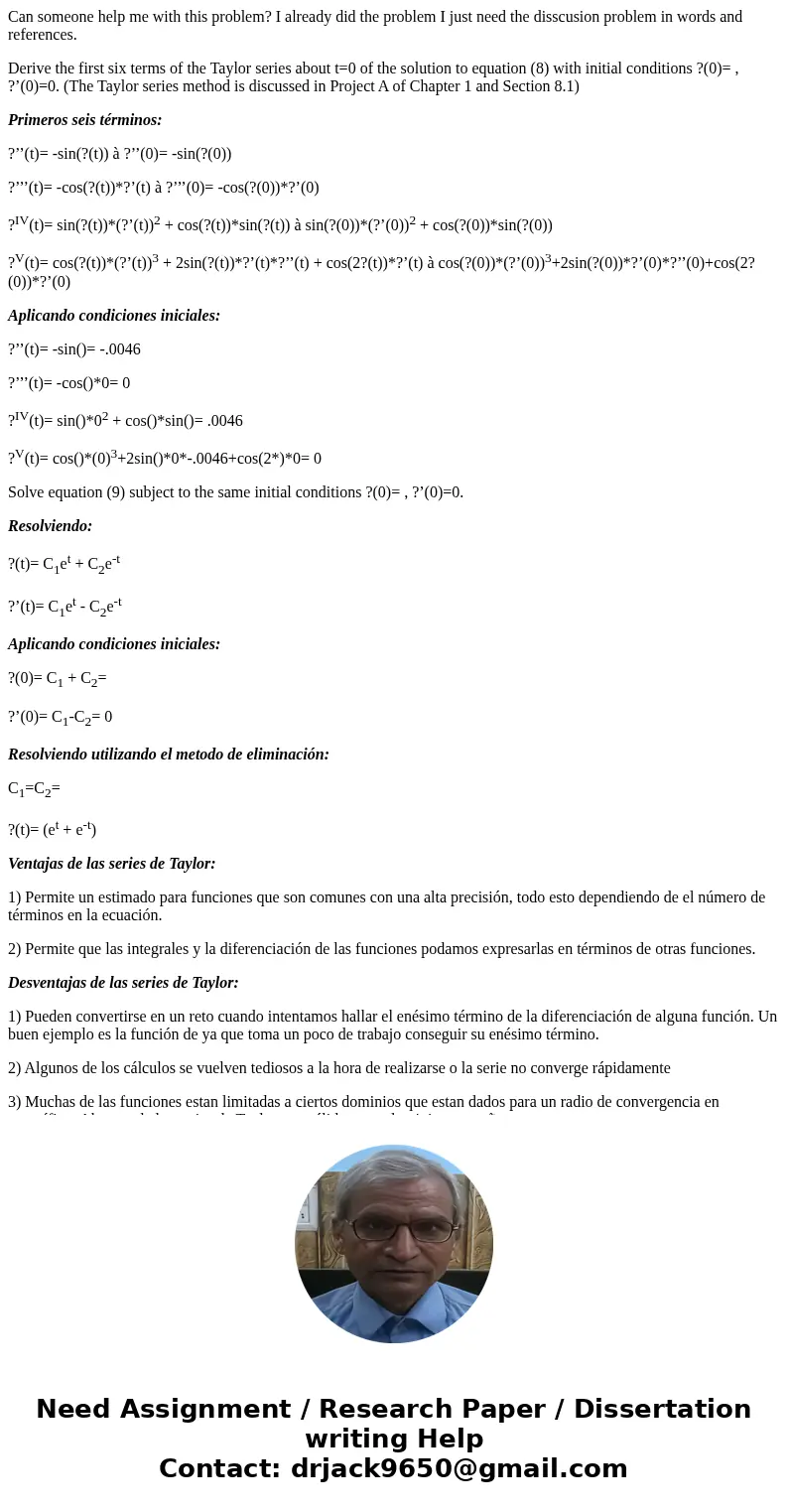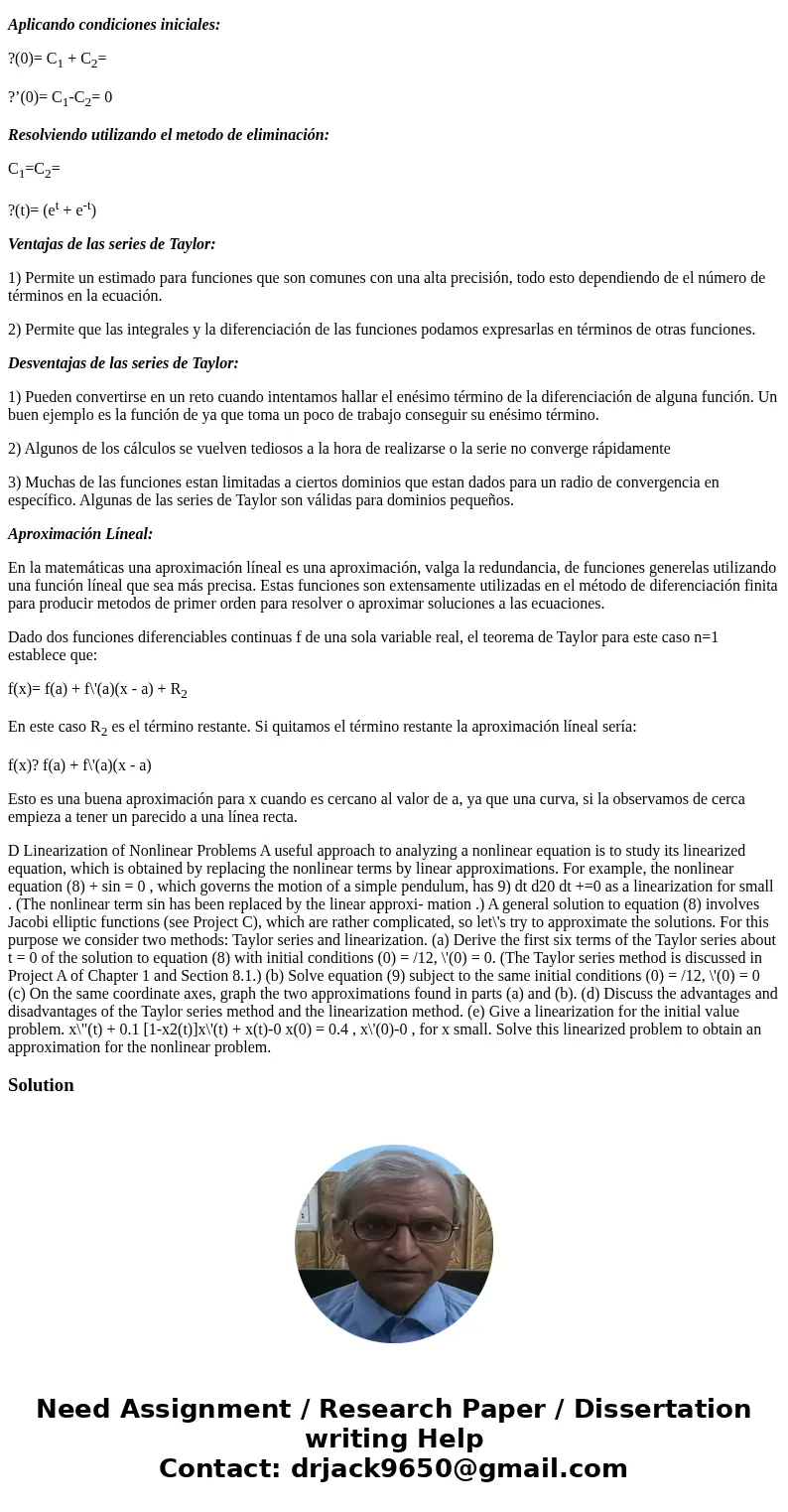Can someone help me with this problem I already did the prob
Can someone help me with this problem? I already did the problem I just need the disscusion problem in words and references.
Derive the first six terms of the Taylor series about t=0 of the solution to equation (8) with initial conditions ?(0)= , ?’(0)=0. (The Taylor series method is discussed in Project A of Chapter 1 and Section 8.1)
Primeros seis términos:
?’’(t)= -sin(?(t)) à ?’’(0)= -sin(?(0))
?’’’(t)= -cos(?(t))*?’(t) à ?’’’(0)= -cos(?(0))*?’(0)
?IV(t)= sin(?(t))*(?’(t))2 + cos(?(t))*sin(?(t)) à sin(?(0))*(?’(0))2 + cos(?(0))*sin(?(0))
?V(t)= cos(?(t))*(?’(t))3 + 2sin(?(t))*?’(t)*?’’(t) + cos(2?(t))*?’(t) à cos(?(0))*(?’(0))3+2sin(?(0))*?’(0)*?’’(0)+cos(2?(0))*?’(0)
Aplicando condiciones iniciales:
?’’(t)= -sin()= -.0046
?’’’(t)= -cos()*0= 0
?IV(t)= sin()*02 + cos()*sin()= .0046
?V(t)= cos()*(0)3+2sin()*0*-.0046+cos(2*)*0= 0
Solve equation (9) subject to the same initial conditions ?(0)= , ?’(0)=0.
Resolviendo:
?(t)= C1et + C2e-t
?’(t)= C1et - C2e-t
Aplicando condiciones iniciales:
?(0)= C1 + C2=
?’(0)= C1-C2= 0
Resolviendo utilizando el metodo de eliminación:
C1=C2=
?(t)= (et + e-t)
Ventajas de las series de Taylor:
1) Permite un estimado para funciones que son comunes con una alta precisión, todo esto dependiendo de el número de términos en la ecuación.
2) Permite que las integrales y la diferenciación de las funciones podamos expresarlas en términos de otras funciones.
Desventajas de las series de Taylor:
1) Pueden convertirse en un reto cuando intentamos hallar el enésimo término de la diferenciación de alguna función. Un buen ejemplo es la función de ya que toma un poco de trabajo conseguir su enésimo término.
2) Algunos de los cálculos se vuelven tediosos a la hora de realizarse o la serie no converge rápidamente
3) Muchas de las funciones estan limitadas a ciertos dominios que estan dados para un radio de convergencia en específico. Algunas de las series de Taylor son válidas para dominios pequeños.
Aproximación Líneal:
En la matemáticas una aproximación líneal es una aproximación, valga la redundancia, de funciones generelas utilizando una función líneal que sea más precisa. Estas funciones son extensamente utilizadas en el método de diferenciación finita para producir metodos de primer orden para resolver o aproximar soluciones a las ecuaciones.
Dado dos funciones diferenciables continuas f de una sola variable real, el teorema de Taylor para este caso n=1 establece que:
f(x)= f(a) + f\'(a)(x - a) + R2
En este caso R2 es el término restante. Si quitamos el término restante la aproximación líneal sería:
f(x)? f(a) + f\'(a)(x - a)
Esto es una buena aproximación para x cuando es cercano al valor de a, ya que una curva, si la observamos de cerca empieza a tener un parecido a una línea recta.
D Linearization of Nonlinear Problems A useful approach to analyzing a nonlinear equation is to study its linearized equation, which is obtained by replacing the nonlinear terms by linear approximations. For example, the nonlinear equation (8) + sin = 0 , which governs the motion of a simple pendulum, has 9) dt d20 dt +=0 as a linearization for small . (The nonlinear term sin has been replaced by the linear approxi- mation .) A general solution to equation (8) involves Jacobi elliptic functions (see Project C), which are rather complicated, so let\'s try to approximate the solutions. For this purpose we consider two methods: Taylor series and linearization. (a) Derive the first six terms of the Taylor series about t = 0 of the solution to equation (8) with initial conditions (0) = /12, \'(0) = 0. (The Taylor series method is discussed in Project A of Chapter 1 and Section 8.1.) (b) Solve equation (9) subject to the same initial conditions (0) = /12, \'(0) = 0 (c) On the same coordinate axes, graph the two approximations found in parts (a) and (b). (d) Discuss the advantages and disadvantages of the Taylor series method and the linearization method. (e) Give a linearization for the initial value problem. x\"(t) + 0.1 [1-x2(t)]x\'(t) + x(t)-0 x(0) = 0.4 , x\'(0)-0 , for x small. Solve this linearized problem to obtain an approximation for the nonlinear problem.Solution


 Homework Sourse
Homework Sourse